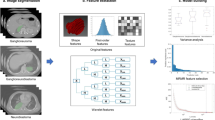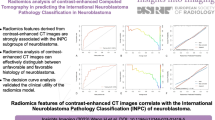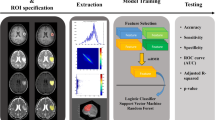Abstract
Purpose
To examine the potential of whole-tumor radiomics analysis of T2-weighted imaging (T2WI) in differentiating neuroblastoma (NB) from ganglioneuroblastoma/ganglioneuroma (GNB/GN) in children.
Materials and methods
This study included 102 children with peripheral neuroblastic tumors, comprising 47 NB patients and 55 GNB/GN patients, which were randomly divided into a training group (n = 72) and a test group (n = 30). Radiomics features were extracted from T2WI images, and feature dimensionality reduction was applied. Linear discriminant analysis was used to construct radiomics models, and one-standard error role combined with leave-one-out cross-validation was used to choose the optimal radiomics model with the least predictive error. Subsequently, the patient age at initial diagnosis and the selected radiomics features were incorporated to construct a combined model. The receiver operator characteristic (ROC) curve, decision curve analysis (DCA) and clinical impact curve (CIC) were applied to evaluate the diagnostic performance and clinical utility of the models.
Results
Fifteen radiomics features were eventually chosen to construct the optimal radiomics model. The area under the curve (AUC) of the radiomics model in the training group and test group was 0.940 [95% confidence interval (CI) 0.886, 0.995] and 0.799 (95%CI 0.632, 0.966), respectively. The combined model, which incorporated patient age and radiomics features, achieved an AUC of 0.963 (95%CI 0.925, 1.000) in the training group and 0.871 (95%CI 0.744, 0.997) in the test group. DCA and CIC demonstrated that the radiomics model and combined model could provide benefits at various thresholds, with the combined model being superior to the radiomics model.
Conclusion
Radiomics features derived from T2WI, in combination with the age of the patient at initial diagnosis, may offer a quantitative method for distinguishing NB from GNB/GN, thus aiding in the pathological differentiation of peripheral neuroblastic tumors in children.
Graphical abstract








Similar content being viewed by others
Data availability
Available from the authors upon reasonable request.
References
Shimada H, Ikegaki N (2022) Genetic and Histopathological Heterogeneity of Neuroblastoma and Precision Therapeutic Approaches for Extremely Unfavorable Histology Subgroups. Biomolecules 12: 79.
Lonergan GJ, Schwab CM, Suarez ES, et al (2002) Neuroblastoma, ganglioneuroblastoma, and ganglioneuroma: radiologic-pathologic correlation. Radiographics 22: 911-934.
Choi JH, Ro JY (2022) Mediastinal neuroblastoma, ganglioneuroblastoma, and ganglioneuroma: Pathology review and diagnostic approach. Semin Diagn Pathol 39: 120-130.
Schmelz K, Toedling J, Huska M, et al (2021) Spatial and temporal intratumour heterogeneity has potential consequences for single biopsy-based neuroblastoma treatment decisions. Nat Commun 12: 6804.
Voss SD (2018) Staging and following common pediatric malignancies: MRI versus CT versus functional imaging. Pediatr Radiol 48: 1324-1336.
Scherer A, Niehues T, Engelbrecht V, et al (2001) Imaging diagnosis of retroperitoneal ganglioneuroma in childhood. Pediatr Radiol 31: 106-110.
Swift CC, Eklund MJ, Kraveka JM, et al (2018) Updates in Diagnosis, Management, and Treatment of Neuroblastoma. Radiographics 38: 566-580.
Dumba M, Jawad N, McHugh K (2015) Neuroblastoma and nephroblastoma: a radiological review. Cancer Imaging 15: 5.
Cai J, Zeng Y, Zheng H, et al (2010) Retroperitoneal ganglioneuroma in children: CT and MRI features with histologic correlation. Eur J Radiol 75: 315-320.
Guan YB, Zhang WD, Zeng QS, et al (2012) CT and MRI findings of thoracic ganglioneuroma. Br J Radiol 85: e365-e372.
Wang X, Pennello G, deSouza NM, et al (2022) Multiparametric Data-driven Imaging Markers: Guidelines for Development, Application and Reporting of Model Outputs in Radiomics. Acad Radiol. doi: https://doi.org/10.1016/j.acra.2022.10.001.
Han YE, Cho Y, Kim MJ, et al (2022) Hepatocellular carcinoma pathologic grade prediction using radiomics and machine learning models of gadoxetic acid-enhanced MRI: a two-center study. Abdom Radiol (NY). doi: https://doi.org/10.1007/s00261-022-03679-y.
Wang H, Chen X, Liu H, et al (2021) [Computed tomography-based radiomics for differential of retroperitoneal neuroblastoma and ganglioneuroblastoma in children]. Nan Fang Yi Ke Da Xue Xue Bao 41: 1569-1576.
Chen X, Wang H, Huang K, et al (2021) CT-Based Radiomics Signature With Machine Learning Predicts MYCN Amplification in Pediatric Abdominal Neuroblastoma. Front Oncol 11: 687884.
Liu G, Poon M, Zapala MA, et al (2022) Incorporating Radiomics into Machine Learning Models to Predict Outcomes of Neuroblastoma. J Digit Imaging 35: 605-612.
Feng L, Yang X, Lu X, et al (2022) Diagnostic Value of 18F-FDG PET/CT-Based Radiomics Nomogram in Bone Marrow Involvement of Pediatric Neuroblastoma. Acad Radiol. https://doi.org/10.1016/j.acra.2022.08.021.
Ghosh A, Yekeler E, Dalal D, et al (2022) Whole-tumour apparent diffusion coefficient (ADC) histogram analysis to identify MYCN-amplification in neuroblastomas: preliminary results. Eur Radiol 32: 8453-8462.
Gassenmaier S, Tsiflikas I, Fuchs J, et al (2020) Feasibility and possible value of quantitative semi-automated diffusion weighted imaging volumetry of neuroblastic tumors. Cancer Imaging 20: 89.
Kamiya A, Murayama S, Kamiya H, et al (2014) Kurtosis and skewness assessments of solid lung nodule density histograms: differentiating malignant from benign nodules on CT. Jpn J Radiol 32: 14-21.
Fujima N, Homma A, Harada T, et al (2019) The utility of MRI histogram and texture analysis for the prediction of histological diagnosis in head and neck malignancies. Cancer Imaging 19: 5.
Goyal A, Razik A, Kandasamy D, et al (2019) Role of MR texture analysis in histological subtyping and grading of renal cell carcinoma: a preliminary study. Abdom Radiol (NY) 44: 3336-3349.
Zwanenburg A, Vallières M, Abdalah MA, et al (2020) The Image Biomarker Standardization Initiative: Standardized Quantitative Radiomics for High-Throughput Image-based Phenotyping. Radiology 295: 328-338.
Sokol E, Desai AV, Applebaum MA, et al (2020) Age, Diagnostic Category, Tumor Grade, and Mitosis-Karyorrhexis Index Are Independently Prognostic in Neuroblastoma: An INRG Project. J Clin Oncol 38: 1906-1918.
Veiga-Canuto D, Cerdà-Alberich L, Sangüesa Nebot C, et al (2022) Comparative Multicentric Evaluation of Inter-Observer Variability in Manual and Automatic Segmentation of Neuroblastic Tumors in Magnetic Resonance Images. Cancers (Basel) 14: 3648.
Funding
The project was funded by Basic Research and Frontier Exploration Project (Yuzhong District, Chongqing, China) (Grant No.20200155).
Author information
Authors and Affiliations
Contributions
Conceptualization: HW. Data curation: HW, XC, WY, MX. Formal analysis: HW. Investigation: HW, HD, LZ, TL and JQ. Methodology: HW. Project administration: HW, XC, LH. Supervision: LH. Validation: HW, XC, MX. Visualization: HW. Writing: HW.
Corresponding author
Ethics declarations
Competing interests
The authors declare that they have no conflict of interest.
Ethical approval
This retrospective study was approved by the ethics committee of our institution.
Consent to participate
The requirement for patient informed consent was waived.
Consent for publication
Authors are responsible for correctness of the statements provided in the manuscript. The Editor-in-Chief reserves the right to reject submissions that do not meet the guidelines described in this section.
Additional information
Publisher's Note
Springer Nature remains neutral with regard to jurisdictional claims in published maps and institutional affiliations.
Rights and permissions
Springer Nature or its licensor (e.g. a society or other partner) holds exclusive rights to this article under a publishing agreement with the author(s) or other rightsholder(s); author self-archiving of the accepted manuscript version of this article is solely governed by the terms of such publishing agreement and applicable law.
About this article
Cite this article
Wang, H., Chen, X., Yu, W. et al. Whole-tumor radiomics analysis of T2-weighted imaging in differentiating neuroblastoma from ganglioneuroblastoma/ganglioneuroma in children: an exploratory study. Abdom Radiol 48, 1372–1382 (2023). https://doi.org/10.1007/s00261-023-03862-9
Received:
Revised:
Accepted:
Published:
Issue Date:
DOI: https://doi.org/10.1007/s00261-023-03862-9




